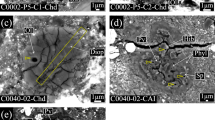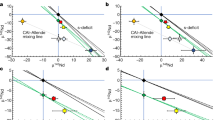Abstract
Primitive or undifferentiated meteorites (chondrites) date back to the origin of the Solar System1, and thus preserve a record of the physical and chemical processes that occurred during the earliest evolution of the accretion disk surrounding the young Sun. The oldest Solar System materials present within these meteorites are millimetre- to centimetre-sized calcium-aluminium-rich inclusions (CAIs) and ferromagnesian silicate spherules (chondrules), which probably originated by thermal processing of pre-existing nebula solids2,3,4. Chondrules are currently believed to have formed ∼2–3 million years (Myr) after CAIs (refs 5–10)—a timescale inconsistent with the dynamical lifespan of small particles in the early Solar System11. Here, we report the presence of excess 26Mg resulting from in situ decay of the short-lived 26Al nuclide in CAIs and chondrules from the Allende meteorite. Six CAIs define an isochron corresponding to an initial 26Al/27Al ratio of (5.25 ± 0.10) × 10-5, and individual model ages with uncertainties as low as ± 30,000 years, suggesting that these objects possibly formed over a period as short as 50,000 years. In contrast, the chondrules record a range of initial 26Al/27Al ratios from (5.66 ± 0.80) to (1.36 ± 0.52) × 10-5, indicating that Allende chondrule formation began contemporaneously with the formation of CAIs, and continued for at least 1.4 Myr. Chondrule formation processes recorded by Allende and other chondrites may have persisted for at least 2–3 Myr in the young Solar System.
This is a preview of subscription content, access via your institution
Access options
Subscribe to this journal
Receive 51 print issues and online access
$199.00 per year
only $3.90 per issue
Buy this article
- Purchase on Springer Link
- Instant access to full article PDF
Prices may be subject to local taxes which are calculated during checkout


Similar content being viewed by others
References
Alexander, C. M. O'D., Boss, A. P. & Carlson, R. W. The early evolution of the inner solar system: A meteoritic perspective. Science 293, 64–68 (2001)
MacPherson, G. J. in Meteorites, Comets and Planets (ed. Davis, A. M.) 201–246, Vol. 1 of Treatise on Geochemistry (eds Holland, H. D. & Turekian, K. K.) (Elsevier-Pergamon, Oxford, 2003).
Rubin, A. E. Petrologic, geochemical and experimental constraints on models of chondrule formation. Earth Sci. Rev. 50, 3–27 (2000)
Shu, F. H., Shang, H., Gounelle, M., Glassgold, A. E. & Lee, T. The origin of chondrules and refractory inclusions in chondritic meteorites. Astrophys. J. 548, 1029–1050 (2001)
Russell, S. S., Srinivasan, G., Huss, G. R., Wasserburg, G. J. & MacPherson, G. J. Evidence for widespread 26Al in the solar nebula and constraints for nebula time scales. Science 273, 757–762 (1996)
Kita, N. T., Nagahara, S. & Morishita, Y. A short duration of chondrule formation in the solar nebula: Evidence from Al-26 in Semarkona ferromagnesian chondrules. Geochim. Cosmochim. Acta 64, 3913–3922 (2000)
Huss, G. R., MacPherson, G. J., Wasserburg, G. J., Russell, S. S. & Srinivasan, G. Aluminum-26 in calcium-aluminum-rich inclusions and chondrules from unequilibrated ordinary chondrites. Meteorit. Planet. Sci. 36, 975–997 (2001)
Mostefaoui, S. et al. The relative formation ages of ferromagnesian chondrules inferred from their initial aluminum-26/aluminum-27 ratios. Meteorit. Planet. Sci. 37, 421–438 (2002)
Hsu, W. B., Huss, G. R. & Wasserburg, G. J. Al-Mg systematics of CAIs, POI, and ferromagnesian chondrules from Ningqiang. Meteorit. Planet. Sci. 38, 35–48 (2003)
Amelin, Y., Krot, A. N., Hutcheon, I. D. & Ulyanov, A. A. Lead isotopic ages of chondrules and calcium-aluminium-rich inclusions. Science 297, 1678–1683 (2002)
Adachi, I., Hayashi, C. & Nakazawa, K. Gas drag effect on elliptic motion of a solid body in primordial solar nebula. Prog. Theor. Phys. 56, 1756–1771 (1976)
Busso, M., Gallino, R. & Wasserburg, G. J. Nucleosynthesis in asymptotic giant branch stars: Relevance for Galactic enrichment and solar system formation. Annu. Rev. Astron. Astrophys. 37, 239–309 (1999)
Goswami, J. N. Short-lived nuclides in the early solar system: the stellar connection. New Astron. Rev. 48, 125–132 (2004)
Sahijpal, S., Goswami, J. N., Davis, A. M., Grossman, L. & Lewis, R. S. A stellar origin for the short-lived nuclides in the early Solar System. Nature 391, 559–561 (1998)
Wasserburg, G. J., Gallino, R., Busso, M., Goswami, J. N. & Raiteri, C. M. Injection of freshly synthesized 41Ca in the early solar nebula by an asymptotic giant branch star. Astrophys. J. 440, L101–L104 (1995)
Marhas, K. K., Goswami, J. N. & Davis, A. M. Short-lived nuclides in hibonite grains from Murchison: Evidence for Solar System evolution. Science 298, 2182–2185 (2002)
Galy, A., Young, E. D., Ash, R. D. & O'Nions, R. K. The formation of chondrules at high gas pressures in the solar nebula. Science 290, 1751–1753 (2000)
Urey, H. C. The cosmic abundances of potassium, uranium, and thorium and the heat balances of the Earth, the Moon and Mars. Proc. Natl Acad. Sci. USA 41, 127–144 (1955)
Srinivasan, G., Goswami, J. N. & Bhandari, N. 26Al in eucrite Piplia Kalan: plausible heat source and formation chronology. Science 284, 1348–1350 (1999)
Bischoff, A. & Keil, K. Al-rich objects in ordinary chondrites: Related origin of carbonaceous and ordinary chondrites and their constituents. Geochim. Cosmochim. Acta 48, 693–709 (1984)
Itoh, S. & Yurimoto, H. Contemporaneous formation of chondrules and refractory inclusions in the early Solar System. Nature 423, 728–731 (2003)
Amelin, Y., Krot, A. & Twelker, E. Pb isotopic age of the CB chondrite Gujba, and the duration of the chondrule formation interval. Geochim. Cosmochim. Acta 68 Abst. E958 (2004)
Briceño, C. et al. The CIDA-QUEST large-scale survey of Orion OB1: Evidence for rapid disk dissipation in a dispersed stellar population. Science 291, 93–96 (2001)
Podosek, F. A. & Cassen, P. Theoretical, observational, and isotopic estimates of lifetime of the solar nebula. Meteoritics 29, 6–25 (1994)
Weidenschilling, S. J., Marzari, F. & Hood, L. L. The origin of chondrules at jovian resonances. Science 279, 681–684 (1998)
Desch, S. J. & Connolly, H. C. A model of the thermal processing of particles in solar nebula shocks: Application to the cooling rates of chondrules. Meteorit. Planet. Sci. 37, 183–207 (2002)
Sanders, I. A. in Chondrules and the protoplanetary disk (eds Hewins, R. H., Jones, R. H. & Scott, E. R. D.) 327–334 (Cambridge Univ. Press, Cambridge, 1996)
McDonough, W. F. & Sun, S.-S. Composition of the Earth. Chem. Geol. 120, 223–253 (1995)
Galy, A. et al. Magnesium isotope heterogeneity of the isotopic standard SRM980 and new reference materials for magnesium-isotope-ratio measurements. J. Anal. Atomic Spectrometry 18, 1352–1356 (2003)
Richter, F. M., Davis, A. M., Ebel, D. S. & Hashimoto, A. Elemental and isotopic fractionation of type B calcium-, aluminum-rich inclusions: Experiments, theoretical considerations, and constraints on their thermal evolution. Geochim. Cosmochim. Acta 66, 521–540 (2002)
Acknowledgements
Financial support for this project was provided by the Danish Lithosphere Centre (funded by the Danish National Science Foundation). M.B. is grateful for financial support in the form of an NSERC postdoctoral fellowship. We thank A. Halliday for his review of this paper.
Author information
Authors and Affiliations
Corresponding author
Ethics declarations
Competing interests
The authors declare that they have no competing financial interests.
Supplementary information
Supplementary Figure 1
Back-scattered electron images and elemental maps of selected chondrules from the Allende meteorite. (PDF 2875 kb)
Rights and permissions
About this article
Cite this article
Bizzarro, M., Baker, J. & Haack, H. Mg isotope evidence for contemporaneous formation of chondrules and refractory inclusions. Nature 431, 275–278 (2004). https://doi.org/10.1038/nature02882
Received:
Accepted:
Issue Date:
DOI: https://doi.org/10.1038/nature02882
This article is cited by
-
Concepts of the Small Body Sample Return Missions - the 1st 10 Million Year Evolution of the Solar System
Space Science Reviews (2020)
-
A review of Mg isotope analytical methods by MC-ICP-MS
Journal of Earth Science (2014)
-
The age of the Solar System redefined by the oldest Pb–Pb age of a meteoritic inclusion
Nature Geoscience (2010)
-
Emergence of a Habitable Planet
Space Science Reviews (2007)
Comments
By submitting a comment you agree to abide by our Terms and Community Guidelines. If you find something abusive or that does not comply with our terms or guidelines please flag it as inappropriate.



